By Jeffrey A. Rendall, Photos By Kevin Gaydosh and Jeffrey A. Rendall
WILLIAMSBURG, VA – Everyone knows, milestones aren’t really worth much unless they really signify something special. After all, age is just a number when you’re talking about most things – and especially in the case of a golf course.
But one of America’s classic layouts turned 50 years old this year – and that means the Golden Horseshoe Golf Club’s Gold Course has been pleasing folks for half a century. It’s definitely an anniversary worth celebrating.
The course itself is not quite the same as the one that opened for business in 1963 (note: the club is celebrating the anniversary all of 2014), a layout that legendary golf architect Robert Trent Jones called ‘My finest design.’ It was decided in the mid-90’s that the layout needed a few alterations in order to make it a little more friendly to the average resort player.
Set on a peerless piece of land, the course had garnered a reputation for being difficult – which isn’t always desirable when its main function is to entertain resort guests.
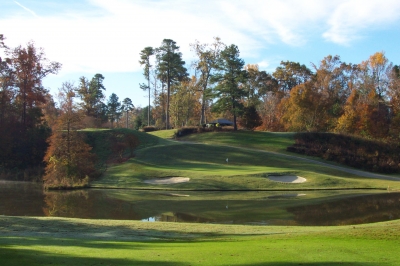 |
| At 498 yards, the par five 2nd hole is definitely reachable -- but you'll have to clear 50 yards of water to get there. |
The late Del Snyder, the Golden Horseshoe Golf Club’s Ambassador of Golf and long-time friend of golf legend Sam Snead, said “Sam only played this course once, and he said it was too difficult to be a resort course.” As a result of Snead’s and others’ similar opinions, Trent Jones’ son Rees was brought in to make some changes.
Rees Jones takes the story from here: “Because I’d built the Green Course (which opened in 1991) for them, I’d developed a very close relationship with Colonial Williamsburg’s Board of Directors. I stayed in touch, and my Dad and I went back and visited in the early nineties.”
“And I’d already done a lot of Robert Trent Jones re-dos – so when they got around to considering an upgrade for the Gold Course, bringing it up to modern technological standards, they asked me to work for them because they really liked what I’d done with the Green Course,” the younger Jones said.
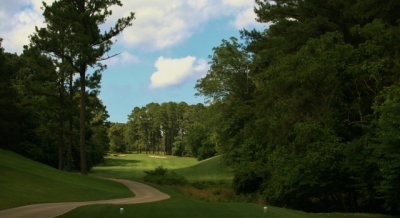 |
| One of the toughest holes you'll ever face, the 435-yard, uphill the whole way 17th hole. It's an intimidating tee shot, too. |
It probably didn’t hurt that Rees’s foreman, Austin Gibson, had not only built the Green Course, he’d actually done the original construction work on the Gold Course project back in the early sixties – and would be coming back again to finish the task in the nineties.
There was a continuation in tradition as well as knowledge when it came to the Jones family name – and when you’re talking about a traditional, historical place like Colonial Williamsburg and the Golden Horseshoe, that’s a giant step towards getting the job right there.
The Jones family’s affection towards Colonial Williamsburg ran deep as well. “My Mom and Dad used to go down there all the time,” Jones remembered. “And I got to be good friends with the people down there as well. I think that’s really the key to success in golf, because when you get emotionally involved, you show up a lot – and you put in all the nuances and final touches along the way.”
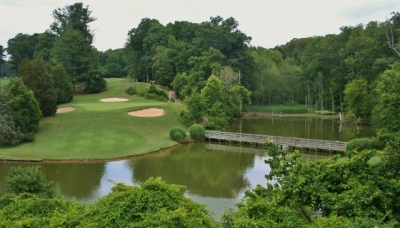 |
| Bridging the lake to the par three 7th hole's green. |
Jones said his dad didn’t have any involvement in the ‘new’ work on the Gold Course, since he was pretty elderly at the time. But the son also kept his father up to date on what was being done, and the senior architect gave his approval. How’s that for a continuum?
Going back a ways, Glen Byrnes, the Golden Horsehoe’s Director of Golf, tells about how golf started at Colonial Williamsburg in the first place: “We first offered golf at the Golden Horseshoe in 1947. The management of the Williamsburg Inn decided we should offer folks staying here the opportunity to play golf, as it was becoming more popular in America at that time.”
Byrnes continues, “So they brought in Fred Findlay to design a nine-hole golf course, and that was called the Williamsburg Inn Golf Course. And then, as golf continued in its popularity, it was decided that, to best serve guests at the Inn – there needed to be an 18-hole Championship Golf Course. So, they brought in the premier architect of the time, Robert Trent Jones, to design it.”
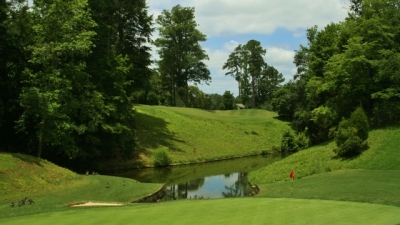 |
| From in back of the par three 3rd hole. Not much margin for error on this one, as there's water in front, slopes to the sides, bunkers to avoid and one heck of a sloped green. |
No doubt, a good choice. Trent Jones took what was already there and created one of America’s truly classic golf designs. Having seen a fair number of private clubs with established reputations, they haven’t anything on the Gold Course in terms of beauty, playability and quality of design. Simply put, it’s one of the best and most enjoyable golf courses anywhere.
Period.
Most of the old nine-hole golf course became what is now the Spotswood Golf Course, a nine-hole executive course that remains a favorite of the Golden Horseshoe’s local members. And if you stay at one of Colonial Williamsburg’s hotels, you can play there, too.
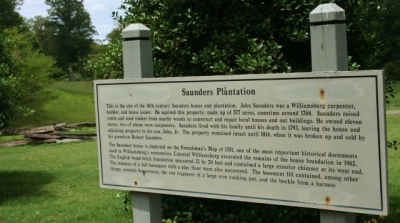 |
| The land that the Gold Course now occupies used to be the Saunders Plantation. History, history, everywhere. |
Like nearly everything at Colonial Williamsburg, the land that the Gold Course occupies was at one time something else – in this case, the original site of the John Saunders Plantation – an 18th century farm that encompassed 577 acres. Colonial Williamsburg excavated the remains of the original house foundation in 1962. Try as you might, you can’t get away from the historical significance of the place.
With that in mind, Rees Jones and the Golden Horseshoe management closed the Gold Course (it re-opened in July of 1998), intent on changing the course only in ways that would make it better.
Jones describes what was done: “We did a lot of fairway grading on the Gold Course, because when my Dad built it in the early sixties, they didn’t have the budget to move a lot of dirt. We graded the holes so they flow in the direction that the hole is going, so it helps with playability.”
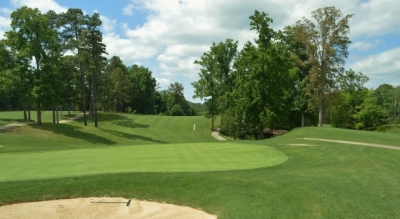 |
| Even the short holes are still difficult on the Gold Course. Here, in back of the par four 13th hole. |
“In the old days, they had to build greens and tees and use the lay of the land as it existed, much like in the British Isles. Now, with the amount of play the Gold Course was getting, we wanted more visibility into the greens – because there aren’t caddies – and you really need to see the targets better. We kept the green sizes and orientations as they were, but also added some tongues – championship hole locations for tournament play,” Jones added.
Jones said they decided to eliminate some of the fall-off qualities of the greens because they were already pretty small, and they added contour on some greens and flattened some others, all with the idea of increasing playability. They also deepened the bunkers.
Along with the golf course strategic improvements, Jones and crew also installed a state-of-the-art irrigation system and paved the cart paths all the way around. These are the types of things you don’t really think about when playing at a place like the Gold Course, but they’re essential for maintaining the outstanding course conditions that you’ll find there.
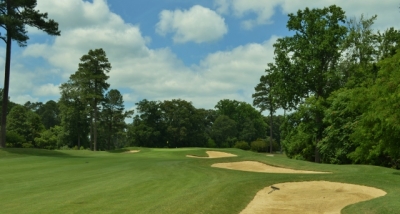 |
| On every hole on the Gold Course, the visual frame is there for you. Looking at the par four 8th hole. |
Jones said he merely did what his father would have done thirty-five years earlier, if he’d had the technological advances available to him. The son’s sensitivity to his father’s classic creation only makes the Gold Course more special, and you can sense that when you’re out there playing it.
At 6,817 yards (par 71 and slope of 144), the Gold Course is not the longest golf course around, but it’s still one of the more difficult challenges in the Mid-Atlantic region. “It’s target golf in a beautiful setting,” Byrnes described it. “There’s a very small area on every hole that you’re aiming at off the tee, so it plays a lot more difficult than it appears – because it looks so open. The greens are small and undulated, so scoring is easier said than done out there.”
“Everything’s natural, there are no houses, and the ravines come into play throughout. Along with the lakes, the topography is extraordinary,” Byrnes expounded.
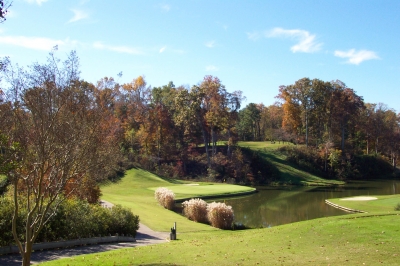 |
| It's all downhill to the par three 12th hole. The tricky wind over the lake makes club selection extra difficult. |
Normally we’d try and filter out, or soften, statements like that. But for the Gold Course, that’s dead-on accurate.
So we’ll let Byrnes talk some more: “The Gold Course is more than just a set of golf holes. The visual beauty that you experience on the golf course throughout the day, coupled with the incredibly well-designed flow of the layout – which offers you holes of every length and shape… you’ll use every club in your bag. Whether you have your best or worst hole, you’ll still enjoy the opportunity to play it.”
Well said. The exacting nature of the course will frustrate you – it’s one of those where you really think you should be scoring better than you are. But never once do you regret being out there, because it’s that great an experience.
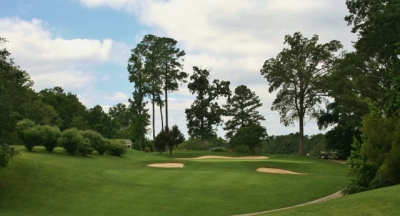 |
| The par five 6th hole is certainly reachable in two for long hitters -- but accuracy is a must. |
The Gold Course has certainly received its share of notoriety over the years, particularly for its four outstanding par threes. “It’s kind of hard to find a better set of par threes than those,” Jones said. “I haven’t seen all the courses around the world, but as far as having a natural setting, demanding, water involved – they’re aesthetically pleasing and exhilarating when you par ‘em.”
The star of the show is the sixteenth, a 169-yard, steeply downhill tee shot to an island green. It’s the one shown on all the photos, and the one that’ll remain etched in your golf mind, long after you’ve hit the road.
Jones said it was one of the first island greens. “Island greens were not in vogue at the time, and Dad may have decided to do that because he’d worked on Ponte Vedra (designed in 1928 by Herbert Strong, and had the first island green). It was the perfect opportunity – but they had to cut away the bank that tied into the green. They actually cut that channel back there to make it an island green.”
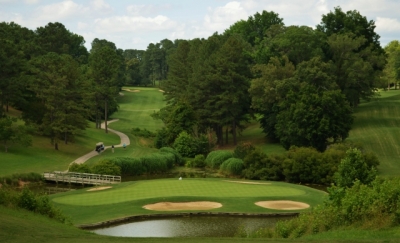 |
| You've seen it before. The par three 16th hole. You'll want to see it again... and again. |
Thankfully, it’s a big island – but be careful of going long.
The same body of water surrounding the sixteenth also figures into three other holes – the par five second, and two more of the Gold’s great par threes, the seventh and twelfth holes. Put together, it’s a panorama of golf that’s virtually unmatched, to enjoy the game of golf in such a natural setting.
As a side note, there’s also a 634-yard par five, the fifteenth. We didn’t ask Jones if that was the longest par five at the time, but even now, it’s a gritty test of strength to reach it in regulation.
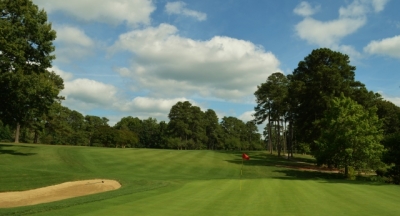 |
| Closing out the round on the par four 18th hole, you will be planning your next visit before you leave the green. |
The remarkable variety of challenging holes is all part of what makes the Gold Course such a classic gem, one that you’ll want to see and play again. “You don’t want to build courses that people only want to play one time,” Jones said. “They want to play golf courses of continuing pleasure and interest, and that’s what I think the members and resort guests have found on the Gold Course – it’s even more pleasurable, and just as challenging after we did the work.”
It’s proof positive that some changes, even to a classic, can only turn out for the better.
And 50 years later, the Gold Course is a place you just want to be. Check it out for yourself.
Details:
The Golden Horseshoe Golf Club (Gold Course)
Phone (757) 220-7696
FAX (757) 565-8841
Website: http://www.colonialwilliamsburg.com/do/wellness-and-recreation/golf/golf-courses/
Ambassador of Golf: Del Snyder
Director of Golf: Glen Byrnes
Course Designers: Robert Trent Jones and Rees Jones
Tees/Yardage/Slope/Rating
Gold 6817 144/73.8
Blue 6522 137/72.6
White 6248 135/71.5
Red 5168 126/69.8
Rates:
As part of Colonial Williamsburg, golf at the Golden Horseshoe is available through a number of attractive package rates, which vary depending on length of stay and type of hotel accommodations.
We suggest checking the web address above for more information.
| Related Links | Comments on this article? | |
|
Maryland National Golf Club Hollow Creek Golf Club Rocky Gap Resort PB Dye Golf Club in Ijamsville Whiskey Creek Golf Club |
E-mail Jeff Rendall, Editor: jrendall@golftheunitedstates.com |












